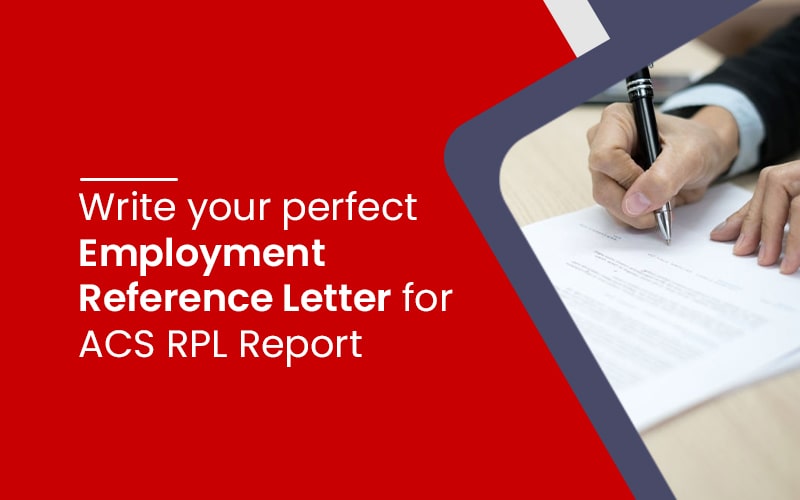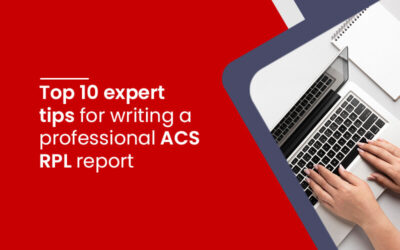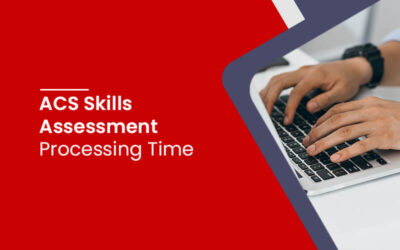Write your perfect Employment Reference Letter for ACS RPL Report.

Table of Contents
- Overview of Employment Reference Letter for ACS RPL Report
- What is skilled employment for the RPL report?
- Format for Employment Reference Letter
- How do you submit your Employment Reference Letter?
- When will your work experience be deemed unsuitable?
- Key areas to focus on while writing your ACS Employment Reference Letter
- Additional points to consider for the Employment Reference Letter
- Reasons for RPL report rejection
- What does CDR Writers Australia provide?
RPL skill assessment is often performed by candidates without ICT skills or tertiary ICT qualifications. The Australian Computer Society (ACS) will analyze your skill assessment before deeming you qualified to move to Australia. As a result, ACS provides applicants who would not otherwise meet the ICT criteria with the opportunity to assess their knowledge and abilities through RPL reports under the ACS Australia Migration Skills Assessment. The RPL report format is already familiar to us. You can go through the document checklist if any confusion arises.
If your academic qualifications and work experience are at a professional ICT level and are closely related to the specified occupation (ANZSCO) for migration purposes, the ACS ICT skills assessment will be considered; nevertheless, the skill and knowledge must be matched. Your credentials and experience are initially assessed or researched to determine AQF comparability based on Australian national education requirements. Following the formation of the AQF, the course modules are evaluated to determine the professional ICT content of your certification or to ensure all knowledge. Each unit is reviewed to see whether it is an ICT professional unit.
As Australia’s professional association and the peak body representing the ICT sector, ACS provides authoritative, independent knowledge and technology insights while developing relevant technology capacity and capability that catalyzes Australian innovation and accelerates technology adoption for commerce, government, and society.
Overview of Employment Reference Letter for ACS RPL Report
An employment reference letter is a required component of an RPL report. As previously indicated, the RPL report is created by applicants who do not have an ICT background or whose ICT abilities need to be improved to meet the Australian Computer Society’s criteria. To establish appropriateness, ACS assesses individuals’ talents and employment experience.
An employment reference letter is an essential component of the RPL report for non-ICT professionals since it represents what they have learned throughout all those years of experience that are equivalent to an ICT degree. Your work reference letter includes information about your educational background, past job history, competencies, and talents. An employer reference letter must be included when submitting an RPL report. The Australian Computer Society is in charge of evaluating your competency, and the standards specified by the ACS must be followed.
What is skilled employment for the RPL report?
An employment opportunity with at least 20 hours per week and payment can be considered for skill assessment. The work must be evaluated at the degree of depth and complexity appropriate for the specified occupation. The degree of expertise necessary should also be reflected in the salary. Please remember that unpaid/partially paid leave or volunteer activities will not be regarded as paid work at the requisite skill level of a specified occupation for skills assessment.
After meeting the ACS eligibility requirements, the employment will be recorded as skilled employment and eligible for migration points. However, work experience to fulfill the eligibility criterion is NOT considered skilled employment and is thus ineligible for migration points.
Format for Employment Reference Letter
The employment reference letter contains information about your educational qualifications, professional experience, abilities, and competence. When candidates file their RPL report, they must attach a work reference letter from their previous employer. The ACS Society will evaluate your RPL report based on your work background and experiences.
An employment reference letter also plays a vital role in helping you get that positive result from the ACS. Work experience must be at the professional ICT level and related to the selected ANZSCO codes to be considered acceptable for migration skills evaluation.
Work experience needs to be at a professional ICT level and related to the chosen occupation for a migration skills assessment to be considered suitable.
Employment reference letter rules are as follows:
- Dates in the DD/MM/YYYY format throughout the job period.
- Position in the given field of work
- Duties accomplished while in the workplace.
- If relevant, previous positions and responsibilities should be stated.
- Working hours: full-time, part-time, and weekly hours worked.
- Locate the address where the work was done.
- Organizational letterhead signed by an authorized individual ( (digital signatures are acceptable and must be verifiable)
Employment Reference Letter points to note
- If you are currently employed, the employer reference should include the phrase “To Date” and the date the reference letter was prepared.
- Experience will only be evaluated until your application’s submission date.
- The description of responsibilities in your work reference determines their relevance to your occupation.
- The work episode will be declared unfit if dates or responsibilities are unclear or subject to interpretation.
- Work experience obtained as part of a qualification is not regarded as skilled employment and is recorded as “Concurrent Employment.”
- Work experience obtained before the candidate attains 18 will not be accepted for skilled employment and will be reported as ‘Not professional level ICT experience.’
- Generic references not mentioning particular responsibilities will be rated as “Not Suitable due to inadequate information.”
- References containing tasks copied and pasted from ANZSCO will not be approved.
An employment reference letter is required for each episode of work. All references must include detailed information from the employer about the responsibilities you accomplished and the skills you used on the job. Your employer or a person authorized by your employer must sign references. The name, position of the job, and contact information of the referring person must be clearly stated.
Read More: Statutory Declarations and Affidavits for ACS Skill Assessment. 🔥🔥
How do you submit your Employment Reference Letter?

When drafting the online applications, applicants must break out employment episodes to indicate “Australia” and “outside of Australia” employment.
Australia Employment:
- Each duration of employment inside Australia must be listed individually in the online application.
Outside Australia Employment:
- If you have worked for various employers or outside Australia, employment is broken up by Australian employment episodes; each duration of employment outside Australia must be documented separately in the online application.
- Suppose you have worked in numerous countries (except Australia) for the same company and in the same or closely similar occupation. In that case, this should be included in the online application as a single period of employment outside of Australia.
When will your work experience be deemed unsuitable?
1. Working at a different employer at the same time
If the applicants complete one employment period while also doing another employment period, only one employment event is recognized at any one moment.
2. ANZSCO is not related to the nominated ANZSCO.
Based on the facts provided in the paperwork, the responsibilities stated have been assessed as not being associated with the defined occupation.
3. Insufficient documentation leads to failed assessment.
If the documentation does not satisfy the requirements of the Skills Assessment Guidelines or is insufficient to meet the assessment criteria, it will be termed as not assessed.
4. Lack of detail causes the work episode not to be evaluable.
The material does not include enough information for ACS to evaluate.
5. Questions Regarding Result Letters
Candidates who wish to inquire about the assessment outcome should contact the ACS through email by referencing their Application ID reference number.
Key areas to focus on while writing your ACS Employment Reference Letter
Suppose you need a well-written employment reference letter for the ACS RPL report. In that case, CDR Writers Australia offers a platform where you can receive the best RPL report writing services and reference samples for your guidance. We’ve highlighted key areas for writing your ACS employment reference letter below.
Proper details on the employment period
The key to success is to create unique, plagiarism-free material. Ensure you write about job experiences and do not attempt to deceive ACS. Furthermore, do not use content from online examples. According to the ANZSCO code, your work experience must be professional and relevant to the selected occupation.
Work experience details
Before applying for the ACS skills assessment, you must have sufficient work experience since ACS has established the minimum work experience necessary to ensure candidates meet the skill level standards.
Only employment that meets the skill level requirements counts as Skilled Employment and qualifies for migration points. When providing an employment reference, remember to mention your work responsibilities, tasks, and skill sets, highlighting all the areas of competence.
Use valid signatures
The employment reference letter you give must be signed/verified by the employer or an authorized organization representative. Details, such as the name and position of the person making the recommendation, must be specified. Using fake signatures on organizations that do not exist may get you banned from re-submitting the application.
Additional points to consider for the Employment Reference Letter
- Work experience should be accumulated at the appropriate level before evaluating skills. ACS has indicated the minimal standard of work experience necessary to meet the required skill level. The date on which the minimum level of competence is attained will be the starting point for migrating as a skilled employee.
- Having an essential degree of experience is critical to being a skilled employee. Work experience obtained before obtaining the minimum specified level of experience will not be considered sufficient, which may negatively impact your RPL. Because of the gap in experience, your RPL will be deemed ineligible for migration.
- Be mindful of the time you spend working while gaining experience in immigration. The immigration authorities have also standardized the situation for you, and the problem of full-time vs. part-time employment is present. It has been explicitly stated that weekly 20-hour duty is the minimum requirement for becoming a full-time employee, and you must include this in your reference letter.
- Every reference must offer specific information about your performance and the talents demonstrated. Your employer will authorize this information. Remember that if you do not provide accurate information about your competence and performance level in your professional sector, your RPL will be ineligible for immigration.
- Any of the authorized notaries should perform the certification. Lack of certification will also cause your RPL to be rejected for immigration purposes since the certified copy of your employer reference letter will be used to assess your ACS competence.
- Try to avoid using any deceptive methods. Do not plagiarize your professional experience or related characteristics from other sources. In your reference letter, mention your genuine job ability, performance level, and degree of experience.
- Try to carefully discuss your talents and professional performances along with your job role suggestion. The purpose of the reference letter is to demonstrate your professional competence throughout the evaluation procedure. As a result, attempt to concentrate more on your strengths and areas of efficiency.
Learn More: Common Misconceptions about CDR Reports for Australian Skilled Migration. ✔️✔️
Reasons for RPL report rejection
The Australian Computer Society looks for RPL reports and RPL reference letters to assess candidates’ competence. Work experience here is quite important in determining the fate of the approval, and ACS verifies your experience by cross-referencing it with the reference letter.
As a result, the RPL report and reference letter must be identical. If those don’t match, they will be rejected. However, there are occasions when candidates receive a good evaluation in the RPL project report but are refused in the reference letter. The following are some of the reasons why a reference letter is rejected:
- Rejection will occur if there is no clear indication of start and finish dates.
- The reference letter’s tasks and responsibilities must correspond to the criteria of the nominated occupation in the ANZSCO codes. As a result, 65 percent of the obligations must be the same, or the letter would be deemed “unsuitable” due to a lack of information.
- Your RPL report and reference letter must be unique. Any plagiarized content will be rejected. Furthermore, the ACS will verify your information, and false information will result in a direct denial.
What does CDR Writers Australia provide?
CDR Writers Australia offers high-quality employment reference letters depending on your work experience and ANZSCO occupation. We have a 100% customer satisfaction rate with our RPL report writing and RPL samples. We also deal with CDR reports, RPL reports, KA02 reports, and Stage 2 competencies. Get your free sample employment reference letter to guide your RPL report.
Recent Posts
- Benefits of RPL Writing for Professional Advancement—Seize the Opportunity! July 8, 2024
- Unlocking Your Potential: Benefits of NER Registration for Engineers—Don’t miss out! July 4, 2024
- 8 Advantages of being a Registered NER Engineer April 25, 2024
- Stage 1 Competency Standard for Professional Engineer December 4, 2023
- Secure Your Future: The Most In Demand Jobs for Skilled Migrants to Australia in 2024 November 3, 2023






